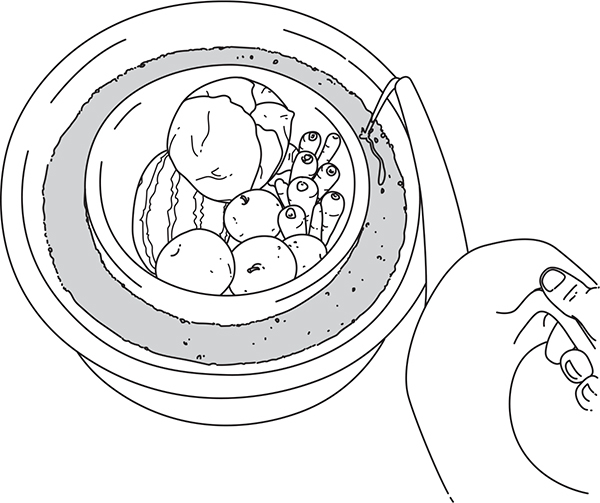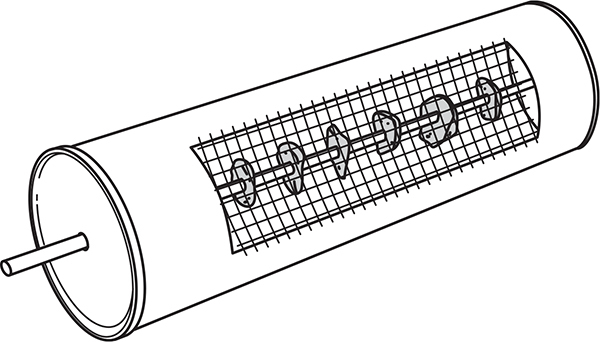BOTTLE CAP SCALER
When processing several fish for a large group of survivors, it’s always better to split the task up to save time and energy. If there’s only one knife available for gutting and cleaning, a team can save time by scaling the fish first using an improvised bottle cap scaler. The sharp, ribbed texture of the bottom of a bottle cap is the perfect tool for the job. Nail the cap (bottom out) to a stick or piece of wood and work it against the scales to quickly remove them. The first person in the processing line can scale, and the second can gut and clean. This makes for a very quick and efficient fish-cleaning arrangement.

POT HANGERS
Here’s a hack that requires almost no product modifications. If you’re an inexperienced camper and need to learn knife skills, it can be a little tricky to hang a pot of stew or water over the fire to boil without some carefully notched sticks. Sometimes, creativity can trump skill in survival, and this is a prime example. Hang a run-of-the-mill wire hanger upside down over a tripod with the hook wrapped around the pot bail. It may not be the bushcraftiest pot hanger in the world, but it sure is one of the fastest hacks I’ve ever used. In survival, it doesn’t matter how it looks; it only matters how it works.
PRESERVATION HACKS
DASHBOARD DEHYDRATOR
On sunny days, the dashboard beneath the big front windshield of a car can get seriously hot. In fact, it’s plenty hot enough to dehydrate meat and vegetables. Dehydrating anything requires some ventilation, so you’ll have to crack the windows a little bit. If flies are an issue, be sure to cover the cracked windows with some mesh or screen.
Cut meat, fruits, and vegetables in thin 1⁄4" strips and then place on the dash on raised drying racks that have at least 2" of clearance for airflow. Any type of mesh or grid trays will work when propped up on small blocks. On an average sunny day meat can be ready to eat in 6–8 hours. Fruits and vegetables can dehydrate even sooner. The addition of a solar-powered fan on the dash can expedite the process. Even when the outside temperature is in the sixties, vehicle interior temperatures can exceed 115°F.
CLAY POT COOLER
Although there is no hack substitute for a good refrigerator, I can show you how to make a very effective evaporative cooler that can extend the shelf life of fruits, vegetables, and other perishable foods. It all starts with 2 porous flower pots, one slightly larger than the other. Standard terra cotta pots work great. First, plug the hole at the bottom of the large pot and fill the bottom with enough sand to raise the top rim of the smaller pot level with the top rim of the larger pot. Second, fill the space in between the pots with sand, then pour in water so that the sand is completely saturated. The evaporation of the water through the outer pot draws heat from the inside of the smaller container, cooling whatever is inside. It helps to place the cooler in a breeze to increase convection. A damp towel over the top of the cooler serves as the perfect lid.

MINI SOLAR DEHYDRATOR
Dehydrating meat to make jerky is a preservation method that every outdoorsman or outdoorswoman should be familiar with. Meat can last for months when the moisture has been removed and the meat has been made into jerky. You can fashion a very simple mini dehydrator from an empty Pringles snack container. The inside of these cylindrical tubes is coated with a silver reflective foil, which is perfect for making a mini solar dehydrator. First, cut a section about 2" × 8" out of the side of the container. Cover the resulting hole with a section of mesh from an old screen window or door to prevent flies from coming inside. This also allows for good airflow, which is very important when making jerky. Put your meat on a skewer and suspend it from 2 holes punched in the lid and in the bottom of the Pringles tube. One day in full sun should be all you need to make a skewer of jerky. This hack solar dehydrator is capable of reaching the ideal dehydrating temperatures of 130°F–170°F. Your jerky is ready when it cracks when bent in half.

Chapter 5
Staying Healthy
FIRST-AID HACKS
Duct Tape Snow Goggles
Plastic Bottle Splint
Heel Driving—A Walking Hack
2-Jacket Stretcher
Hack Your Temperature with a Wet Bandana
Bra Cup Debris Mask
Charcoal Tummy Aid
Cotter Pin Tweezers
Orbit Goggles
Makeshift Butterfly Bandage
A Better-Than-Nothing Soup Can Gas Mask
Survival Eyeblack
2-Liter Safety Goggles
The Best Natural Mosquito Repellent
A Not-So-StrAWEful Tick Puller
Horsefly Shotgun
HYGIENE HACKS
BBQ Spit Bath
Ultralight Clothespins
SELF-DEFENSE HACKS
Riot Mask
Twisted Paracord Perimeter Alarm
Smoke Alarm Perimeter Guard
55-Gallon Battle Shield
Cardboard Body Armor
The Sport of Self-Defense
From Plumb Bob to Rope Dart
Nothing else matters when you don’t have your health. This is certainly true in a survival scenario. Even the simplest injury to a hand or eye can be devastating when you’re fighting to provide yourself with shelter, water, fire, and food. From sunburn to broken bones, much in this chapter is dedicated to hacking yourself back together in the event of an incident requiring first aid.
As many a doctor will say, “The best cure is prevention.” This is certainly true in a survival scenario when access to medical facilities and supplies may be limited, or nonexistent altogether.
Some scenarios are more dangerous than others. Certainly, large-scale natural disaster and civil unrest top the list. It’s not hard to imagine an event that might call for some degree of self-defense. This chapter concludes with hacks using everyday objects that can be used to protect you from nature, beasts, and your fellow humans.
FIRST-AID HACKS
DUCT TAPE SNOW GOGGLES
Snow blindness (photokeratitis) is a very real phenomenon. Imagine sunburn-like symptoms except they occur on your cornea. It’s not only painful but it can literally blind you until it heals several days later. Hacking an Inuit-inspired pair of snow goggles is the best solution. First, tear off 2 6" strips of duct tape and stick them together, sticky side in. Then cut 2 slits where the eyes will be. Lastly, attach a head strap by poking holes on each end of the duct tape goggles. The slit reduces the eyes’ exposure to sunlight and thus helps to prevent a burn on the eyeballs. Dark fabric, leather, and bark can also be used instead of duct tape.

PLASTIC BOTTLE SPLINT
If you know much about construction, then you may know that curves are very strong. Even thin materials become very strong and rigid when shaped into a C trough shape. For this reason, many of the world’s bestselling splints for broken and fractured limbs are in the form of a C. Almost all round plastic bottles can quickly be converted into this shape. Trim off the top and bottom of the bottle, then smash and force the upper half into the lower half’s curve. This will make for a very sturdy trough-style splint. If you want to make the splint even more rigid or longer, sandwich several bottles together. Place this splint over the extremity and lash it into place to reduce movement and protect the injury during travel.